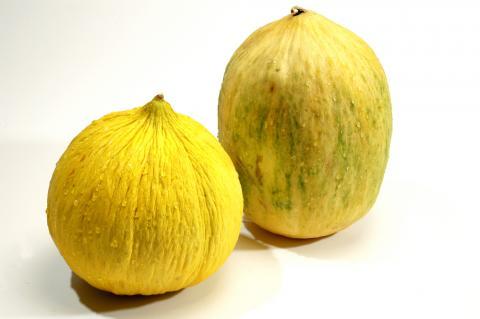
Crenshaw melons are listed in the United States Department of Agriculture (USDA) in the family Cucurbitaceae or the cucumber family of the genus Cucumis L., commonly known as melon in the species Cucumis melo L. or cantaloupe.
Crenshaw melons are one of the sweetest varieties in the melon genus and are a hybrid cross between the Persian and Casaba melons and a crossbred of the inodorous group of melons. Crenshaw melons were imported from Turkey in the 20th century and have become a product of California. The melons are available from July to September and are eaten as a refreshing snack, included in fruit salads, and used as dessert toppings. They do well in the backyard garden but they are a delicate fruit that does not store for a long period of time. They are rich in nutrients that help to maintain a healthy body.
Crenshaw melons are grown in two varieties: the white melon is the most common and tolerates direct sunlight while the green variety is less popular. They are included in the inodorous group of melons that are larger and less fragrant than other melons. They grow in the temperate and warm regions and grow well in the desert areas during the off seasons of spring and fall. Crenshaw melons have a waxy outer skin with a golden, yellow hue accented with green spots. The flesh is a pink-orange color with a high liquid content and when ripe a melon weighs from six to ten pounds. The flesh has a sweet, slightly spicy flavor.
Crenshaw Melons are Nutritious!
Crenshaw melons are rich in nutrients containing vitamins B6 and C, as well as potassium. They also contain vitamin A, calcium, and iron.
There are many health benefits to eating Crenshaw melons; containing B vitamins they energize the body by converting carbohydrates into fuel. Because they are low in saturated fats they are ideal for those on a weight loss diet. Their high fiber content regulates the digestive system, reducing the incidents of constipation. The melon also contains antioxidants which keep the skin healthy and reduce its aging.
Other health benefits of Crenshaw melons are produced by the presence of vitamin C which aids in oral health, strong nails, and healthy hair. It boosts the immune system and reduces the risk of infection. The vitamin A content is beneficial for ocular health, reducing the risk of developing diseases of the eye.
Crenshaw Melons are Fun to Grow & Eat!
Crenshaw melons can be a nice addition to the backyard garden. They require a long growing season and in colder climates should be started indoors about six weeks before the last frost. Keep the pots warm (around eighty degrees Fahrenheit) for quicker germination. Outdoors, plant the seedlings one foot apart, and they can be trellised. Protect the roots by leaving them covered with the potting soil. Choose a warm location and use a planting cloth cover to keep the ground warm and be sure to keep the plants moist. The melons are ready to pick when they turn yellow and are easily taken off the vine.
Crenshaw melons are a hearty fruit that can be incorporated into many recipes. They are a refreshing snack eaten off the rind or included in fruit salads. They can be sliced into pieces and caramelized in a hot skillet for topping ice cream and other desserts. They can be skewered with pineapple and mango and cooked on the grill. They are excellent with cured meats and fresh mozzarella cheese.








